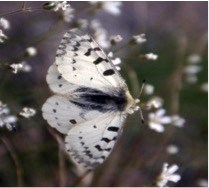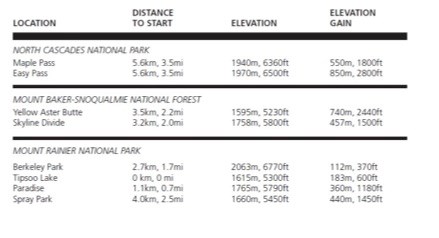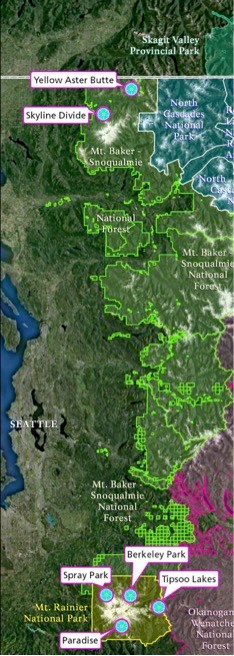Last updated: August 8, 2017
Article
Cascades Butterfly Project Research

Introduction
Climate change is expected to affect mountain ecosystems in many ways. Scientists predict that warmer summers may result in earlier snowmelt, more frequent forest fires, and changes in distributions of plants and animals. Although some ecosystem changes (e.g., melting glaciers) have already been observed, many future impacts remain uncertain. Monitoring provides a way to document ecosystem changes, anticipate future changes, and improve management of protected lands.
Butterflies are sensitive indicators of climate change because temperature influences the timing of an individual’s life cycle and the geographic distribution of species. As individuals develop from egg to larvae to pupae and finally to mature butterfly, temperature thresholds may trigger these changes. Annual temperature patterns are often the primary determinant of the distribution of “generalist” butterflies.
Generalist butterflies are species that can utilize many different plant species for nectar, larval development, and egg deposition. Specialist butterflies depend on a few plant species for food and development and they can be directly and indirectly influenced by climate (temperature and precipitation). An example of indirect influences is when climate limits the growth of the butterflies’ “host” plants; when the quality or number of these plants decline, so do the number of butterflies.
Recently, studies in Europe and California have documented range shifts in butterflies in response to changing temperatures. As average annual temperatures have increased, some species have responded by moving northward or to higher elevations to follow optimal temperature ranges. However, scientists still have a lot of unanswered questions about the long-term survival of these species. For instance, even if butterflies are able to fly to higher elevations in response to warming temperatures, will they be able to establish as breeding residents? Will host plants be able to migrate up quickly enough to support butterfly populations, or will some species become extinct?

Methods
We are establishing a program to monitor butterflies to learn how climate is affecting their populations in six protected areas of the Cascade Mountains. The six areas include four sites in Washington: North Cascades National Park, Mount Baker- Snoqualmie National Forest, Okanagan- Wenatchee National Forest, and Mount Rainier National Park and two areas in British Columbia: Skagit and Manning provincial parks.
We are using two approaches to study butterflies: inventory and monitoring. First, we are conducting inventories of butterflies across our landscape. Second, we are establishing permanent transects to monitor changes in butterfly abundance and species diversity. Permanent transects will be established in three areas: North Cascades National Park, Mount Baker-Snoqualmie National Forest, and Mount Rainier National Park. Along each transect, volunteers will record butterfly abundance and plants in flower.
Photo-inventories
In partnership with the Butterflies and Moths of North America Project (http://www.butterfliesandmoths.org), we are working with volunteers to develop photo inventories. Volunteers out hiking obtain detailed photos of butterflies, and mark their location on a map. They upload photos to a website and share where it was taken by marking the location of the photo on a map. We are working with butterfly experts who will study your photo and either verify your identification or identify the butterfly for you. These photo observations will help scientists document the distribution of butterfly species throughout the protected areas in order to better predict and study how these species will respond to a changing climate.
Butterfly Transects (see table)
We are establishing eight 1-km transects in subalpine meadows across our study area. Each week, volunteers walk a transect and document every butterfly in a 5-m wide band. Botanical forays conducted in this area create a baseline for understanding butterfly responses to timing of plant flowering. All transects are along trails and most transects are within a couple of miles of a roads.

